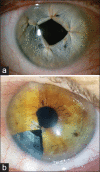Iris reconstruction: A perspective on the modern surgical armamentarium
- PMID: 34345138
- PMCID: PMC8300278
- DOI: 10.4103/ojo.ojo_160_21
Iris reconstruction: A perspective on the modern surgical armamentarium
Abstract
The surgical reconstruction of eyes with iris defects is almost invariably complex and challenging. A number of prosthetic iris devices are available including large-incision, rigid diaphragm, aniridic intraocular lens style devices, small-incision devices incorporating a capsular ring, and flexible, customized, small-incision iris prostheses. The surgical techniques for rehabilitation are dictated by the configuration of the iris defect, the presence of concurrent ocular pathology, and the functional complaint of the patient. Successful rehabilitation requires careful surgical planning and appropriate patient selection. Nonetheless, endowed with the modern surgical armamentarium, the reconstructive surgeon may achieve significant functional and cosmetic improvement.
Keywords: Artificial iris; iris reconstruction; pupilloplasty.
Copyright: © 2021 Oman Ophthalmic Society.
Figures





References
-
- Barton JJ, Radcliffe N, Cherkasova MV, Edelman J, Intriligator JM. Information processing during face recognition: The effects of familiarity, inversion, and morphing on scanning fixations. Perception. 2006;35:1089–105. - PubMed
-
- Weissberg E, Suckow M, Thorn F. Minimal angle horizontal strabismus detectable by lay observers. Optom Vis Sci. 2004;81:505–9. - PubMed
-
- Mayer CS, Reznicek L, Hoffmann AE. Pupillary reconstruction and outcome after artificial iris implantation. Ophthalmology. 2016;123:1011–8. - PubMed
Publication types
LinkOut - more resources
Full Text Sources
